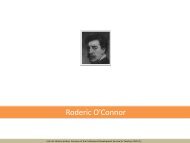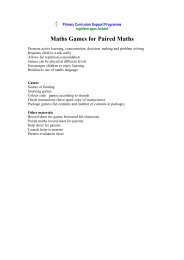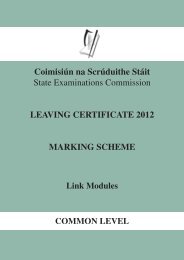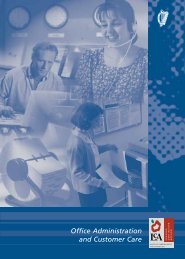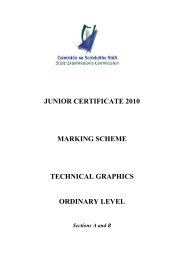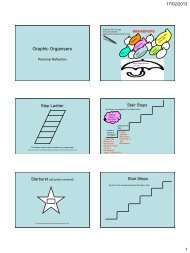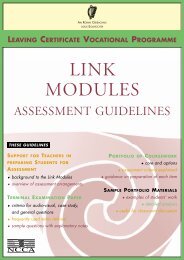What is Four in Balance? - PDST
What is Four in Balance? - PDST
What is Four in Balance? - PDST
Create successful ePaper yourself
Turn your PDF publications into a flip-book with our unique Google optimized e-Paper software.
2 - Benefits of us<strong>in</strong>g ICTA good example of asynchronous e-learn<strong>in</strong>g <strong>is</strong> the Khan Academy(www.khanacademy.org/), which has more than 2000 <strong>in</strong>structional videosthat pupils can watch whenever it suits them.A more radical form of e-learn<strong>in</strong>g <strong>is</strong> the digital tutor, an overall<strong>in</strong>struction program that pupils can work through with m<strong>in</strong>imal teacher<strong>in</strong>tervention. It <strong>is</strong> particularly popular <strong>in</strong> higher education (for examplethe Open University of the Netherlands), but primary schools are alsoexperiment<strong>in</strong>g with it. For example, some Dutch primary schools used adigital tutor for their Engl<strong>is</strong>h lessons (Hovius, 2010). The tutors guided thepupils through a series of topics <strong>in</strong> Engl<strong>is</strong>h on the <strong>in</strong>teractive whiteboard,address<strong>in</strong>g them <strong>in</strong> native-speaker-quality Engl<strong>is</strong>h. The pupils alsowatched films and carried out assignments. The pupils who had receivedlessons from the digital tutor were just as motivated and performed just aswell as the control group pupils who had been <strong>in</strong>structed by a teacher <strong>in</strong>the traditional manner.There <strong>is</strong> little evidence that such e-learn<strong>in</strong>g methods actually improveteach<strong>in</strong>g and learn<strong>in</strong>g, however (Lemke, 2009). <strong>What</strong> <strong>is</strong> certa<strong>in</strong> <strong>is</strong> that theyrequire teachers to have outstand<strong>in</strong>g skills, for example so that they canma<strong>in</strong>ta<strong>in</strong> order <strong>in</strong> onl<strong>in</strong>e classes, check whether pupils understand thematerial, and relate the digital material to the regular material.2.4 Structured practiceThe po<strong>in</strong>t of knowledge transfer <strong>is</strong> to give pupils a solid knowledge base.Knowledge transfer <strong>in</strong>volves convey<strong>in</strong>g new knowledge to pupils (Section2.3), but it <strong>is</strong> also vital for that knowledge to “stick” and for pupils to beable to recall it immediately. The most suitable learn<strong>in</strong>g activity for th<strong>is</strong><strong>is</strong> practice (mak<strong>in</strong>g knowledge automatic). We def<strong>in</strong>e practic<strong>in</strong>g broadlyto mean the rote memorization of facts (such as words), the application oflearned rules (such as grammar rules) and skills exerc<strong>is</strong>es (such as learn<strong>in</strong>gto touch type).Positive results have been achieved with practice software, subject to theright conditions. A well-designed program should allow pupils to practice21



